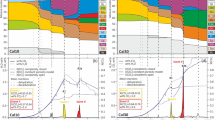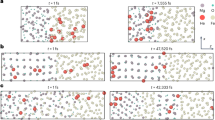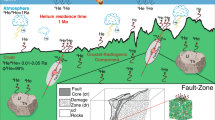Abstract
Helium, nitrogen and hydrogen are continually generated within the deep continental crust1,2,3,4,5,6,7,8,9. Conceptual degassing models for quiescent continental crust are dominated by an assumption that these gases are dissolved in water, and that vertical transport in shallower sedimentary systems is by diffusion within water-filled pore space (for example, refs. 7,8). Gas-phase exsolution is crucial for concentrating helium and forming a societal resource. Here we show that crustal nitrogen from the crystalline basement alone—degassing at a steady state in proportion to crustal helium-4 generation—can reach sufficient concentrations at the base of some sedimentary basins to form a free gas phase. Using a gas diffusion model coupled with sedimentary basin evolution, we demonstrate, using a classic intracratonic sedimentary basin (Williston Basin, North America), that crustal nitrogen reaches saturation and forms a gas phase; in this basin, as early as about 140 million years ago. Helium partitions into this gas phase. This gas formation mechanism accounts for the observed primary nitrogen–helium gas discovered in the basal sedimentary lithology of this and other basins, predicts co-occurrence of crustal gas-phase hydrogen, and reduces the flux of helium into overlying strata by about 30 per cent because of phase solubility buffering. Identification of this gas phase formation mechanism provides a quantitative insight to assess the helium and hydrogen resource potential in similar intracontinental sedimentary basins found worldwide.
This is a preview of subscription content, access via your institution
Access options
Access Nature and 54 other Nature Portfolio journals
Get Nature+, our best-value online-access subscription
$29.99 / 30 days
cancel any time
Subscribe to this journal
Receive 51 print issues and online access
$199.00 per year
only $3.90 per issue
Buy this article
- Purchase on Springer Link
- Instant access to full article PDF
Prices may be subject to local taxes which are calculated during checkout




Similar content being viewed by others
Data availability
All data are previously published and available in ref. 7, with data tables uploaded to an open-source repository at https://doi.org/10.5281/zenodo.7267734. Source data are provided with this paper.
Code availability
The code for the numerical model developed for this paper can be accessed on an open-source repository at https://doi.org/10.5281/zenodo.7271773.
References
Aggarwal, P. K. et al. Continental degassing of 4He by surficial discharge of deep groundwater. Nat. Geosci. 8, 35–39 (2015).
Andrews, J. et al. Radioelements, radiogenic helium and age relationships for groundwaters from the granites at Stripa, Sweden. Geochim. Cosmochim. Acta 46, 1533–1543 (1982).
Sleep, N., Meibom, A., Fridriksson, T., Coleman, R. & Bird, D. H2-rich fluids from serpentinisation: geochemical and biotic implications. Proc. Natl Acad. Sci. USA 101, 12818–12823 (2004).
Lin, L.-H. et al. Long-term sustainability of a high-energy, low-diversity crustal biome. Science 314, 479–482 (2006).
Sherwood Lollar, B., Onstott, T., Lacrampe-Couloume, G. & Ballentine, C. The contribution of the Precambrian continental lithosphere to global H2 production. Nature 516, 379–382 (2014).
Danabalan, D. et al. The principles of helium exploration. Pet. Geosci. https://doi.org/10.1144/petgeo2021-029 (2022).
Cheng, A. et al. Determining the role of diffusion and basement flux in controlling 4He distribution in sedimentary basin fluids. Earth Planet. Sci. Lett. 574, 117175 (2021).
Mamyrin, B. A. & Tolstikhin, I. N. Helium Isotopes in Nature (Elsevier, 2013).
Ballentine, C. J. & Burnard, P. G. Production, release and transport of noble gases in the continental crust. Rev. Mineral. Geochem. 47, 481–538 (2002).
Lin, L.-H., Slater, G. F., Sherwood Lollar, B., Lacrampe-Couloume, G. & Onstott, T. C. The yield and isotopic composition of radiolytic H2, a potential energy source for the deep subsurface biosphere. Geochim. Cosmochim. Acta 69, 893–903 (2005).
Gold, T. & Held, M. Helium–nitrogen–methane systematics in natural gases of Texas and Kansas. J. Pet. Geol 10, 415–424 (1987).
Ballentine, C. J. & Sherwood Lollar, B. Regional groundwater focusing of nitrogen and noble gases into the Hugoton-Panhandle giant gas field, USA. Geochim. Cosmochim. Acta 66, 2483–2497 (2002).
Boreham, C. J. et al. Helium in the Australian liquefied natural gas economy. APPEA J. 58, 209–237 (2018).
Kotarba, M. J. & Nagao, K. Composition and origin of natural gases accumulated in the Polish and Ukrainian parts of the Carpathian region: gaseous hydrocarbons, noble gases, carbon dioxide and nitrogen. Chem. Geol. 255, 426–438 (2008).
Regenspurg, S. et al. Geochemical properties of saline geothermal fluids from the in-situ geothermal laboratory Groß Schönebeck (Germany). Geochemistry 70, 3–12 (2010).
Hiyagon, H. & Kennedy, B. Noble gases in CH4-rich gas fields, Alberta, Canada. Geochim. Cosmochim. Acta 56, 1569–1589 (1992).
Jenden, P., Kaplan, I., Poreda, R. & Craig, H. Origin of nitrogen-rich natural gases in the California Great Valley: evidence from helium, carbon and nitrogen isotope ratios. Geochim. Cosmochim. Acta 52, 851–861 (1988).
Li, L. et al. N2 in deep subsurface fracture fluids of the Canadian Shield: source and possible recycling processes. Chem. Geol. 585, 120571 (2021).
Karolytė, R. et al. The role of porosity in H2/He production ratios in fracture fluids from the Witwatersrand Basin, South Africa. Chem. Geol. 595, 120788 (2022).
Holland, G. et al. Deep fracture fluids isolated in the crust since the Precambrian era. Nature 497, 357–360 (2013).
Warr, O. et al. Tracing ancient hydrogeological fracture network age and compartmentalisation using noble gases. Geochim. Cosmochim. Acta 222, 340–362 (2018).
Warr, O., Giunta, T., Ballentine, C. J. & Sherwood Lollar, B. Mechanisms and rates of 4He, 40Ar, and H2 production and accumulation in fracture fluids in Precambrian Shield environments. Chem. Geol. 530, 119322 (2019).
Torgersen, T. Continental degassing flux of 4He and its variability. Geochem. Geophys. Geosyst. 11, Q06002 (2010).
Torgersen, T. & Clarke, W. Helium accumulation in groundwater, I: An evaluation of sources and the continental flux of crustal 4He in the Great Artesian Basin, Australia. Geochim. Cosmochim. Acta 49, 1211–1218 (1985).
Torgersen, T., Habermehl, M. & Clarke, W. Crustal helium fluxes and heat flow in the Great Artesian Basin, Australia. Chem. Geol. 102, 139–152 (1992).
Castro, M. C., Goblet, P., Ledoux, E., Violette, S. & de Marsily, G. Noble gases as natural tracers of water circulation in the Paris Basin: 2. Calibration of a groundwater flow model using noble gas isotope data. Water Resour. Res. 34, 2467–2483 (1998).
Byrne, D., Barry, P., Lawson, M. & Ballentine, C. The use of noble gas isotopes to constrain subsurface fluid flow and hydrocarbon migration in the East Texas Basin. Geochim. Cosmochim. Acta 268, 186–208 (2020).
Lowenstern, J. B., Evans, W. C., Bergfeld, D. & Hunt, A. G. Prodigious degassing of a billion years of accumulated radiogenic helium at Yellowstone. Nature 506, 355–358 (2014).
Bare, S. R. The Helium Crisis. APS Phys. https://www.aps.org/policy/analysis/helium-crisis.cfm (2016).
Gluyas, J. G. The emergence of the helium industry. The history of helium exploration, Part 1. AAPG Explorer January 2019 16–17 (2019).
Gluyas, J. G. Helium shortages and emerging helium provinces. The history of helium exploration, Part 2. AAPG Explorer February 2019 18–19 (2019).
Sorenson, R. P. J. A. B. A dynamic model for the Permian Panhandle and Hugoton fields, western Anadarko Basin. AAPG Bull. 89, 921–938 (2005).
Ferguson, G. et al. The persistence of brines in sedimentary basins. Geophys. Res. Lett. 45, 4851–4858 (2018).
Wang, X. et al. Radiogenic helium concentration and isotope variations in crustal gas pools from Sichuan Basin, China. Appl. Geochem. 117, 104586 (2020).
Anderson, C. C. & Hinson, H. H. Helium-Bearing Natural Gases of the United States: Analyses and Analytical Methods Bulletin 486 (US Bureau of Mines, 1951).
Harris, D. C. & Baranoski, M. T. Cambrian Pre-Knox Group Play in the Appalachian Basin (Ohio Division of Geological Survey, 1997).
Mao, S. & Duan, Z. A thermodynamic model for calculating nitrogen solubility, gas phase composition and density of the N2–H2O–NaCl system. Fluid Phase Equilib. 248, 103–114 (2006).
Yurkowski, M. M. Helium in Southwestern Saskatchewan: Accumulation and Geological Setting Open File Report 1 (Saskatchewan Ministry of the Economy, Saskatchewan Geological Survey, 2016).
Danabalan, D. Helium: Exploration Methodology for a Strategic Resource (Durham Univ., 2017).
Thompson, J. The occurrence of helium in the Cambrian near Swift Current, Saskatchewan. Third International Williston Basin Symposium 179–184 (1964).
Snyder, G. L. Map of Precambrian and adjacent Phanerozoic rocks of the Hartville uplift, Goshen, Niobrara, and Platte counties, Wyoming Report No. 2331-1258 (1980).
Munnerlyn, R. D. & Miller, R. D. Helium-Bearing Natural Gases of the United States: Analyses, Second Supplement to Bulletin 486 Bulletin 617 (US Bureau of Mines, 1963).
Bachu, S. & Hitchon, B. Regional-scale flow of formation waters in the Williston Basin. AAPG Bull. 80, 248–264 (1996).
Zhu, C. & Hajnal, Z. Tectonic development of the northern Williston Basin: a seismic interpretation of an east-west regional profile. Can. J. Earth Sci. 30, 621–630 (1993).
Kent, D. in Geological Atlas of the Western Canada Sedimentary Basin (eds Mossop, G. D. & Shetsen, I.) 69–86 (Canadian Society of Petroleum Geologists and Alberta Research Council, 1994).
Price, R. in Geological Atlas of the Western Canada Sedimentary Basin (eds Mossop, G. D. & Shetsen, I.) 13–24 (Canadian Society of Petroleum Geologists and Alberta Research Council, 1994).
Wright, G., McMechan, M. & Potter, D. in Geological Atlas of the Western Canada Sedimentary Basin (eds Mossop, G. D. & Shetsen, I.) 25–40 (Canadian Society of Petroleum Geologists and Alberta Research Council, 1994).
Terzaghi, K. Theoretical Soil Mechanics 11–15 (Wiley, 1943).
Cadogan, S. P., Maitland, G. C. & Trusler, J. M. Diffusion coefficients of CO2 and N2 in water at temperatures between 298.15 K and 423.15 K at pressures up to 45 MPa. J. Chem. Eng. Data 59, 519–525 (2014).
Sherwood Lollar, B., Weise, S., Frape, S. & Barker, J. Isotopic constraints on the migration of hydrocarbon and helium gases of southwestern Ontario. Bull. Can. Petrol. Geol. 42, 283–295 (1994).
Sherwood Lollar, B. et al. Unravelling abiogenic and biogenic sources of methane in the Earth’s deep subsurface. Chem. Geol. 226, 328–339 (2006).
Telling, J. et al. Bioenergetic constraints on microbial hydrogen utilisation in Precambrian deep crustal fracture fluids. Geomicrobiol. J. 35, 108–119 (2018).
Onstott, T. C. et al. The origin and age of biogeochemical trends in deep fracture water of the Witwatersrand Basin, South Africa. Geomicrobiol. J. 23, 369–414 (2006).
Heard, A. W. et al. South African crustal fracture fluids preserve paleometeoric water signatures for up to tens of millions of years. Chem. Geol. 493, 379–395 (2018).
Ward, J. et al. Microbial hydrocarbon gases in the Witwatersrand Basin, South Africa: implications for the deep biosphere. Geochim. Cosmochim. Acta 68, 3239–3250 (2004).
Acknowledgements
This study was supported by funding from China Scholarship Council, the Oxford Department of Earth Sciences, the Natural Sciences and Engineering Research Council of Canada, and the NERC Centre for Doctoral Training in Oil and Gas. C.J.B. and B.S.L. are fellows of the CIFAR Earth 4D Subsurface Science and Exploration programme.
Author information
Authors and Affiliations
Contributions
Conceptualization: C.J.B., B.S.L., J.G.G. and A.C. Methodology: A.C., C.J.B. and B.S.L. Formal analysis and investigation: A.C. Software: A.C. Visualization: A.C. and C.J.B. Writing—original draft preparation: A.C. Writing—review and editing: A.C., C.J.B., B.S.L. and J.G.G. Funding acquisition: C.J.B. and B.S.L. Supervision: C.J.B. and B.S.L. All authors reviewed the results and approved the final version of the manuscript.
Corresponding authors
Ethics declarations
Competing interests
The authors declare no competing interests.
Peer review
Peer review information
Nature thanks Werner Aeschbach and the other, anonymous, reviewer(s) for their contribution to the peer review of this work. Peer reviewer reports are available.
Additional information
Publisher’s note Springer Nature remains neutral with regard to jurisdictional claims in published maps and institutional affiliations.
Extended data figures and tables
Extended Data Fig. 1 Examples of diffusive concentration profiles of helium and nitrogen with the diffusion-only model.
The diffusive concentration profiles of helium (a,b) from the diffusion-only model are shown for a basement flux of 0.8 × 10−6 mol 4He m−2 yr−1 and 1.6 × 10−6 mol 4He m−2 yr−1. The concentration profiles presented are modelled results considering several aquifer flushing events in the past million years (natural recharge and anthropogenic flooding)7. For each helium flux value, the nitrogen profiles modelled are with N2/4He basement flux ratios of 13, 25 and 50, respectively (c,d) with the diffusion-only model. The horizontal lines are the boundaries of lithological units. The dotted black lines are the solubility of nitrogen over a range of salinities (labelled to the right of each line). From right-most to the left, the lines correspond to salinities of 0, 10, 25, 50, 100, 150, 200, 250 and 300‰ respectively. The solid red lines represent the saturation limit for different formation waters estimated from salinity maps produced by ref. 43. If the predicted nitrogen concentration for a particular 4He flux and basement N2/4He exceeds solubility (that is, the coloured concentration line is higher than the solid red line), a nitrogen gas phase is predicted. When helium basement flux is 0.8 × 10−6 mol 4He m−2 yr−1, gas is predicted to form only in the basal units when N2/4He is 50. As demonstrated in the figure, when helium basement flux is 1.6 × 10−6 mol 4He m−2 yr−1, gas is predicted to develop in the bottom unit when N2/4He is 25 and in units from Cambrian up to Devonian when N2/4He is 50.
Extended Data Fig. 2 Gas composition obtained from diffusion and exsolution model over a range of basement helium and N2/4He flux.
The plots present the modelled (a) 4He/20Ne ratios, (b) 4He concentration, (c) N2/4He ratios in the gas phase and gas–water ratio (Vg/Vl) in the Cambrian Deadwood Formation. The shaded areas are constrained by the lower and upper limits of the samples. By overlapping plots (a) (b) and (c), plot (d) demonstrates the best-estimated combinations of 4He basement flux and N2/4He ratios to be4He basement flux of 0.8 × 10−6–1.6 × 10−6 mol 4He m−2 yr−1 and basement N2/4He ranges between 30 and 50.
Supplementary information
Supplementary Video 1
Visualization of timing and magnitude of gas-phase formation. The video shows an example of the diffusion and exsolution model run with a He flux of 1.6 × 10−6 mol 4He m−2 yr−1 and a N2/4He flux ratio of 50 run for 500 Ma with 0.1-Ma time resolution. Sedimentary units are added throughout geological time7. The left and middle panels show the concentration profiles of 4He and N2 simulated from the diffusion–exsolution model, respectively. The red dashed line represents the solubility limit of N2 for different sedimentary units as the model progresses. The right panel shows the gas–water ratio through geological time simulated from the diffusion–exsolution model. With these parameters, a gas phase may have formed in the Deadwood Formation as early as about 140 Ma.
Rights and permissions
Springer Nature or its licensor (e.g. a society or other partner) holds exclusive rights to this article under a publishing agreement with the author(s) or other rightsholder(s); author self-archiving of the accepted manuscript version of this article is solely governed by the terms of such publishing agreement and applicable law.
About this article
Cite this article
Cheng, A., Sherwood Lollar, B., Gluyas, J.G. et al. Primary N2–He gas field formation in intracratonic sedimentary basins. Nature 615, 94–99 (2023). https://doi.org/10.1038/s41586-022-05659-0
Received:
Accepted:
Published:
Issue Date:
DOI: https://doi.org/10.1038/s41586-022-05659-0
Comments
By submitting a comment you agree to abide by our Terms and Community Guidelines. If you find something abusive or that does not comply with our terms or guidelines please flag it as inappropriate.



